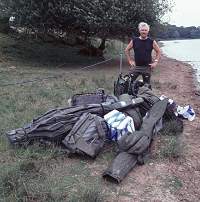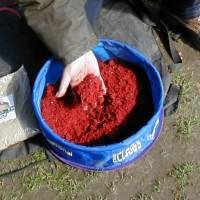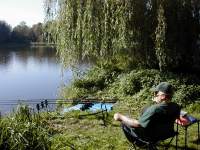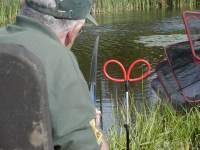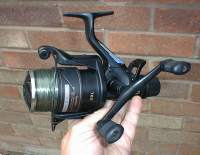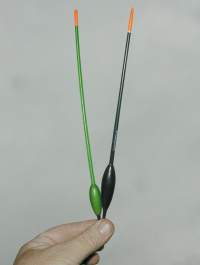|
|
| |
Dave will use heavy gear to fish for big barbel one day and a pole on ultra-light tackle the next to bag up on roach.
The emphasis in this new series is how to enjoy your fishing no matter where you’re fishing or what you’re fishing for.
Kit Care
I’m not really sure how I got into this piece. I was talking to Graham about what would be appropriate for the next article in the ‘Purely for Pleasure’ series and he said he was looking for someone to write a piece about tackle maintenance. “Where’s the pleasure in that?” I asked “And I’m really bad at caring for my tackle anyway”.
“You’ll know all the consequences of not doing it then wont you,” he replied.
Thinking about it, you know, he’s right, so here goes…
|
|
| |
So why do we find it so difficult to respect our tackle at the end of a session and put it away properly, having first taken the time to get it clean and dry? Who knows, it’s what makes us human I guess. I shall forever be amazed that penicillin was not discovered by a fisherman due to the amount of mould that we have grown over the years on damp tackle dumped into a musty old shed or garage.
And I bet I’m not the only angler who thinks packing up at the end of the day is the worst thing about going fishing, especially on wet days when all the kit is soaked through. I am certainly guilty of hastily stuffing tackle into a spare gap in the holdall where it does not belong and then chucking all the gear into the car in a disorganised heap. And when I get home all I want to do is get indoors to have a hot shower and a feed, so the already untidy heap gets lobbed into the garage to be sorted out ‘tomorrow’. That ‘tomorrow’ often turns into two or three days because something else has to be done and the tackle gets forgotten, left where it was dumped, still damp and disorganised.
On the worst occasions, when I eventually get round to cleaning it, I have found a disgusting mess, mould growing on leftover bait and sometimes even on the damp cork handles of my rods.
If only I would take that extra bit of time and effort when I get home it would really pay dividends. Thankfully most rods and reels these days are pretty tough and clean up well enough and a lot of the accessories are made from durable plastic.
But some of the other stuff, like nets, holdalls, groundbait buckets and the like are perishable and should be treated with a little bit of respect. At the very least on returning from a session these items should be unloaded, cleaned and hung in an airy place to dry as quickly as possible. This at least will stop them from smelling extremely bad and will probably extend their life enormously.
|
|
| |
Cleaning out bait boxes is a must as I’m sure you have discovered. A box of maggots left for a few days can get pretty rank and it is not a pleasant job getting them out. Of course an added benefit of doing this job straight away is that a lot of bait can be saved and reused, even maggots. If another trip is planned in the next couple of day’s maggots can be popped into a fridge. If not, bagging them up, adding a bit of flavour and putting them in the freezer means they can be used whenever as feed. Leftover meat, corn and pastes can also be frozen. In fact a lot, especially bait that has been flavoured previously, will actually improve with freezing.
That’s covered what should be done (not what I necessarily do) at the end of a session, particularly where gear has got a bit wet. Let’s now look at some of the routine tasks that can be performed on kit to keep it looking good and performing at its best.
Rods
You guys who own split cane rods will know all about tackle maintenance and you probably actually enjoy it. Why else would anyone want to fish with a bit of stick, unless they were mad? Only joking guys, honest, and on a serious note old split cane rods etc, are usually a specialist field so I won’t attempt to cover their upkeep here (nothing to do with the fact that I have never owned one and wouldn’t know how to maintain one).
|
|
| better for a good clean |
Check your rod rings and make sure they are in good condition, especially the tip and butt rings as they take the most punishment. Braided lines are proving to wear tip rings far faster than mono, so if you use braid on a regular basis pay attention to your tip ring. If there is any sign of damage to any ring or whipping, replace it. If you don’t feel confident doing it yourself, a tackle shop is normally happy to do it for you.
The rod joints should be checked regularly too. Keep them free from dirt to prevent excessive wear. You can also add wax or silicon to the male spigots to extend the life of joints and stop them becoming sloppy.
If you own a quiver tip rod, check your quiver inserts for damage. The glass ones especially are easy to spit without you necessarily noticing, until it’s too late of course and they give out on a fish or the line gets caught when casting and causes a crack off.
Poles
The joints on a pole are by far the most important part as they take a fair bit of wear and tear, especially the top three and four joints where the pole is most often broken down while fishing. Keep the joints clean and dry, and use one of the commercial silicon protectors to keep a permanent coating on the joint.
|
|
| |
Check your elastics regularly for abrasions and weaknesses, especially around the knots. Replace any with signs of wear.
Reels
Unless you are really confident with modern fixed spool reels I would not recommend stripping them down. They are very complex pieces of kit and once taken apart are very difficult to reassemble. But, as with most other pieces of tackle, you can keep them clean. Wash them under cold water every now and again to remove caked on groundbait and other dirt, dry them off and spray the moving parts with a water repelling lubricant like WD40.
|
|
| |
Centrepin reels, although not as complex as fixed spools, are precision made instruments and require careful maintenance. It is wise to be extra careful when using a ‘pin’ and not to let dirt get behind the spool in the first place. But they will get dirty, so again clean them and keep the bearings lubricated with a small amount of light machine oil.
Line
Line should be checked regularly for abrasions over the first 30 metres or so. If it shows any sign of wear strip it off. Don’t leave line with nicks on your reel, it can only cost you fish! Make sure spools on your fixed spool reels remain adequately filled though or casting will be impaired.
|
|
| |
Braided lines last much longer than mono’s as they are not light sensitive and don’t need changing as often. In fact they will probably only need changing when they become too short and don’t sufficiently fill the spool. Which is just as well given the cost of them.
Floats
Yes, floats. Although, floats are probably not usually thought of as requiring maintenance, you can save yourself a lot of money by looking after them.
|
|
| |
Hooks
Hooks these days are usually chemically sharpened and once they are blunt, they don’t sharpen up too well. Discard hooks that have caught a few fish, especially the small ones, they really are not worth the effort of trying to keep sharp. The really important thing about hooks is to keep them dry. If you get water in the packet, unused hooks will quickly corrode and become useless before you have used them.
|
|
| |
So there you have it. A run down of just some of the things you should do to look after your expensive tackle items, written by a bloke who is still learning the lessons the hard way. And, you know, if you can’t actually get out fishing, there is still pleasure to be had by just tinkering around with your tackle and making sure it’s ready to do the business when you do go next.











